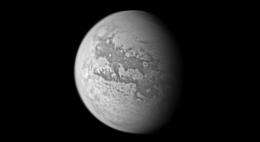March 23, 2012 weblog
Probe mission to explore Titan's miniscule rainfall proposed

(PhysOrg.com) -- Dr. Ralph Lorenz of Johns Hopkins Applied Physics Laboratory (JHUAPL) outside of Baltimore has given a talk at the Lunar and Planetary Science Conference (LPSC) in Texas outlining what has been learned about rainfall on Titan, one of Saturn’s moons. He then offered a proposal for sending a new probe to its surface to study the rainfall in more detail. Titan and Earth are the only “worlds” in our solar system that have rainfall, though on Titan, it falls as methane, not water.
Lorenz points out that what is believed to have been rainfall on Titan has been observed in the past; once in 2004 and then again in 2007. Both events were recorded by the Cassini probe. He says that rain falling has led to the formation of rivers, lakes and streams despite an annual surface temperature of just -179°C. Titan gets a lot less rain than Earth, and has far less clouds. On Earth, we typically get 50-65% cloud cover at any given time, whereas on Titan, it’s more like 0.2-0.6%. This results in sometimes centuries passing between rain showers, which as expected dump a lot of rain when they do occur. But that’s when looking at the moon as a whole. When looking at just the poles, rainfall appears to occur far more often. In fact, Lorenz points out, if a probe were to sit on the surface near the northern pole, it would have a fifty-fifty chance of being rained on if it sat there for 2500 hours (96 Earth days), which he is suggesting would be the duration of his proposed Titan Mare Explorer (TiME), which would land in Ligeia Mare, one of Titan’s lakes.
Lorenz’s proposed probe mission is one of three currently being considered by NASA; the winner will be announced next month.
In the earlier observed rain showers, dark patches appeared on Titan’s surface, which appeared to correlate with associated cloud cover. Researchers concluded that it must have been rain showers due also to the fact that the darkening slowly disappeared over time, consistent with evaporation. Lorenz would like to send a probe to prove that such occurrences truly are rain showers.
One of Lorenz’s colleagues, Dr Elizabeth Turtle, also spoke at the conference in support of the mission, saying that her studies of the more recent rainfall, showed that the texture of the surface had changed significantly due to what is believed to have been a rainstorm, with dark patches on the surface covering about 500,000 sq km which could be clearly seen after the passing of the cloud cover.
If Lorenz’s proposal effort is successful, the TiME probe would land on Titan sometime in 2023.
More information:
http://www.lpi.usra.edu/meetings/lpsc2012/pdf/2472.pdf
via BBC
© 2011 PhysOrg.com




















